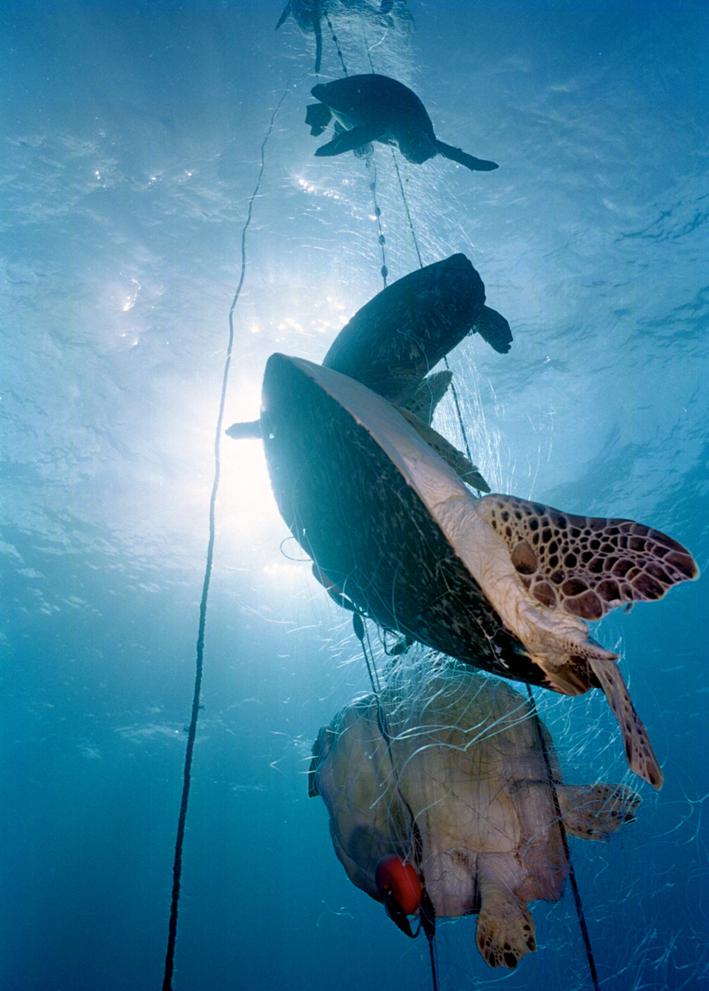New study shows that nearshore fisheries pose a significant bycatch threat that rivals the impacts of large-scale open ocean fisheries.
Arlington, Va. – The most comprehensive global evaluation of fisheries bycatch impacts on large marine species, published this month in the journal Ecosphere, revealed that sea turtle populations in the East Pacific, North Atlantic, Southwest Atlantic, and Mediterranean face higher bycatch and mortality rates. The study also highlighted information gaps that are blocking further assessments of impacts, and found that bycatch rates in small-scale fisheries in nearshore areas rival those of large-scale fisheries in the open ocean. Currently, six out of the seven species of sea turtles are endangered globally, and without effective measures to reduce bycatch, many sea turtle populations around the world could face local extinction.
“We lose hundreds or thousands of turtles each year in populations that are already at risk,” said Dr. Bryan Wallace, of Oceanic Society and Duke University. “Many sea turtle populations around the world could face local extinction if we don’t reduce bycatch.”
The findings are the result of a comprehensive assessment of fisheries bycatch – the accidental capture and injury of marine animals in fishing gear that are not the target catch species – from multiple fishing gears to-date for any large marine species. Researchers at Conservation International, Oceanic Society, San Diego State University, Duke University, and Stanford University analyzed data from more than 1800 bycatch records over the last two decades to determine the regions and types of fishing gear with the highest impacts on sea turtles.
“This study should serve as an initial roadmap to prioritize investment of limited resources to sustainably manage fisheries to minimize bycatch,” Wallace continued. “Our analyses demonstrate where and how sea turtles are being accidentally killed and inform decisions on what steps we can take to reverse the decline of turtle populations.”
Sea turtles play important roles in maintaining healthy marine ecosystems. They feed on sea grasses, sponges, and jellyfish, which can help to maintain habitats that serve as nurseries for other species and support healthy fish populations.
The analysis also exposed significant gaps in available bycatch data around Africa, in the North Indian Ocean, and in Southeast Asia, which prevented the researchers from evaluating bycatch rates in these regions. Turtle populations in these regions are already under high threat from human exploitation of their eggs, meat and shell material and fishing activity in areas where turtles occur is high.
Researchers assessed bycatch impacts of three different categories of fishing gear, and found that on a global scale, mortality from nets and trawls was greater than from longlines. “This came as a bit of a surprise because longlines have been thought to be the primary source of bycatch of turtles and other non-target species such as seabirds,” said Rebecca Lewison of San Diego State University, a study co-author. “These results show that while mitigating sea turtle bycatch in longlines—like those anchored to the bottom—is still necessary, reducing turtle bycatch in net and trawl fisheries worldwide should be given more attention than it has received in the past.”
Sea turtles were also found to face high bycatch threats from small-scale, near-shore fisheries, especially in areas where turtles concentrate to feed and nest. “Bycatch in small-scale fisheries is rarely monitored or regulated, but can have disproportionately large impacts on turtles and other bycatch species,” Wallace added. “But these fisheries are also disproportionately important socioeconomically for coastal communities worldwide, so bycatch reduction has to be balanced with the livelihoods of fishermen.”
In fact, the highest bycatch rates in the world have been documented in small-scale fishing gear off Baja California, Mexico. Despite numbering only 100 boats, this small fishing fleet accidentally catches and kills as many loggerhead turtles each year as all other fisheries in the North Pacific combined. Just last year, more than 2,000 turtles of this endangered population were killed—a 600-percent increase over previous mortality estimates.
Though this situation is dire, Wallace says that there is still hope. “Fisheries and environment managers in Mexico can reduce loggerhead bycatch by protecting turtles in their important feeding and breeding areas, managing the amount and types of gear being used and working with small-scale fishermen to implement techniques that reduce bycatch,” he said. “The loggerhead bycatch situation is being closely watched around the world, so if it is handled well, it could be a great model for other places to follow.”
A study published last year in Biological Conservation, which Wallace co-authored, illustrated that several tools are available to managers to reduce mortality of sea turtles due to bycatch. For example, bycatch reduction measures, including use of turtle excluder devices in shrimp trawlers, implemented in U.S. fisheries reduced overall accidental sea turtle deaths by 90 percent over two decades.
"The presence of sea turtles is a sign of a healthy ecosystem with a high level of biodiversity, which can support healthy fisheries," said Sebastian Troeng, Senior Vice President for the Global Marine Program at CI, who conducted his doctoral research on sea turtles. "This landmark study provides decision makers with a guide on how to prioritize bycatch prevention, which is a key component of sustainable fisheries management and absolutely necessary for global food security." (Article's Source)
Turtles in trouble: sea turtles in East Pacific, North Atlantic, Southwest Atlantic, and Mediterranean face higher bycatch mortality rates


 People
People Photos
Photos Videos
Videos Communication Materials
Communication Materials